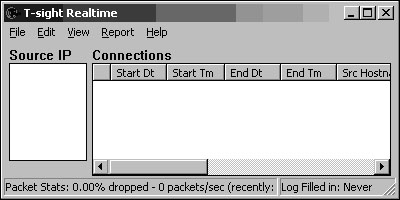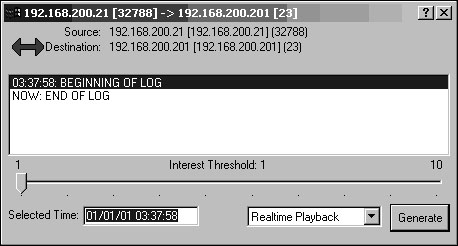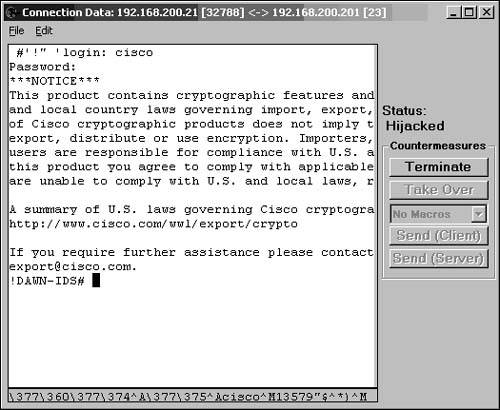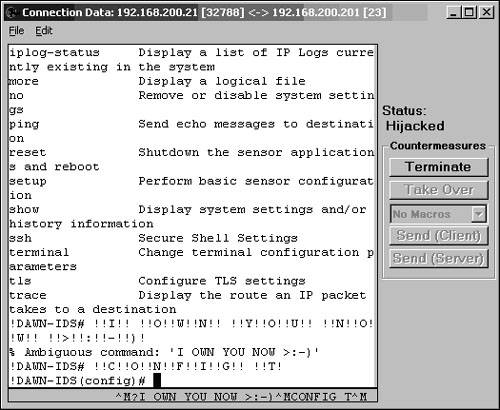Case Study
| < Day Day Up > |
| This section looks at a basic session hijacking attack against a Telnet session using T-Sight. You can use the same scenario against any Cisco device systems that allow TCP session connections, such as Telnet. This case study shows a poorly designed IDS network, where the command and control interface is accessible to hacker Evil Jimmy. To set the scene, the company named Little Company Network (also known as LCN) has had some recent security issues, and management has allowed the networking team to purchase and install an IDS. As expected, the team rushed right out and bought a new Cisco IDS and installed several inexpensive hubs to get the maximum viewing of their newfound toy. The team also purchased IEV to monitor and record alarms. The team did not have enough computers or network equipment to place the command and control interface on a separate secure network, and time was of the essence to get it installed. It decided to connect the command and control interface to the standard LAN. It knew it should not do that, but it thought the risks were minimal and put forth efforts to make it more difficult to break into. The team knew that the IEV and IDS communication was SSL, which is generally secure, so this was considered safe. Then the team gave the sensor a long 10-character password to help thwart password guessing to the command and control interface. Next, it enabled Telnet on the system for ease of access, just like it did on all other networking devices. LCN knows that Telnet is insecure somehow, so the team made sure that the IDS was configured to allow only the computer IP addresses of the networking teams to connect via Telnet to the command on control interface. Finally, the team could install the IEV collection software on an existing computer on the network and save hardware costs. With all this done, the team felt it was ready to launch into production and connect the command and control interface into the LAN. Figure 6-41 shows the LCN network and where Evil Jimmy will be hijacking the session. Figure 6-41. LCN Network It was here that things started to go wrong. The team never should have configured Telnet on the IDS. This weakness gave Evil Jimmy the patience to wait in the background for the LCN networking team to Telnet, at which point he could hijack the session and compromise the entire IDS. Evil Jimmy will probably not destroy the system, but just disable all the alarms he might trigger over the next few weeks. This allows Evil Jimmy free reign over the network because the LCN networking team will be blindly watching for alarms on a system that Evil Jimmy completely controls. Note This scenario of connecting the command and control interface to the standard LAN is not that far fetched. However, the configuration of Telnet on any Cisco system such as PIX Firewalls, routers, switches, and IDS should never be done at all costs. Watch as Evil Jimmy goes to work:
This type of attack demonstrates the dangers of session hijacking. To prevent against malicious hackers like Evil Jimmy, disable Telnet on all your devices and enable something better, such as SSH (which most Cisco devices support). Tip The authors of this book have seen and taken advantage of clients using this network design along with dozens of router and PIX installations where internal Telnet was enabled. This type of data makes great data for your Penetration Test Report! Even when you cannot successfully use session hijacking, there are other ways to hijack a session, which you will see in Chapter 9, "Cracking Passwords." |
| < Day Day Up > |
EAN: 2147483647
Pages: 209
- An Emerging Strategy for E-Business IT Governance
- Measuring and Managing E-Business Initiatives Through the Balanced Scorecard
- Technical Issues Related to IT Governance Tactics: Product Metrics, Measurements and Process Control
- Governing Information Technology Through COBIT
- The Evolution of IT Governance at NB Power





